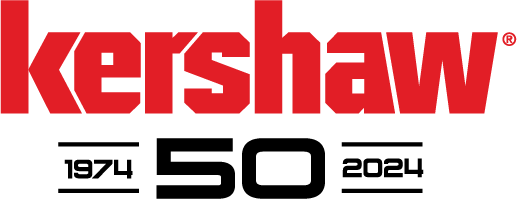We use cookies to make your experience better. To comply with the new e-Privacy directive, we need to ask for your consent to set the cookies. Learn more.

Automatic Knife Release Form
You must read and fill out this form before Kai USA, Ltd. can sell to you, or ship to you, any Automatic or Butterfly Knives. By electronically signing this online form, you confirm that you are in compliance with the federal statutes shown below as well as any applicable state and local regulation.
By placing an order or receiving a product service (such as warranty repair service) from us, you agree that you meet any or all of the following criteria:
APPLICABLE FEDERAL STATUTES
18 U.S.C. § 1716 (G) (2) (1-4) provides, in summary:
Switchblade (automatic) knives can be shipped to civilian and armed forces supply or procurement officers and employees of the federal government ordering or procuring or purchasing such knives in connection with activities of the Federal government; to supply or procurement officers in the National Guard, the Air National Guard or militia of the state or territory of the District of Columbia ordering, procuring or purchasing such knives in connections with the activities of such organizations; to supply or procurement officers or employees of the municipal government of the District of Columbia or the government of any state or territory of any county, city or other political subdivision of a state or territory ordering, procuring or purchasing such knives in connection with the activities of such government.
15 U.S.C. § 1244 provides, in summary:
Knives can be shipped by common carrier; that sale, transportation or distribution, possession or introduction into interstate commerce of switchblade knives is authorized if it is pursuant to a contract with the armed forces; or, any member or employee thereof acting in the performance of his or her duty may possess switchblade knives and may have them shipped to him and sold to him or her. The possession and transportation upon his or her person of a switchblade knife or a blade 3 inches or less is authorized to any handicapped individual who has the use of only one arm.
STATE LAW PROVISIONS
It would be impossible to provide an exhaustive review of the laws that may apply in the various fifty states and in the various counties, parishes, municipalities, and other political subdivisions within each state. By signing this form below, you will be certifying that in addition to complying with federal law, you have determined which, if any, state or local laws apply to you, and that you are acting in compliance with those laws.
No Post Office Box addresses can be used on this form. Item(s) must be sent in going UPS or Fed Ex. No USPS shipments will be accepted. If the address that you have filled out on this form is no longer a valid address, you must contact us and fill out a new form.
f-18 form successfully submitted
A confirmation will be sent to your email shortly. You can find your signed form in your Account.
Please note, you cannot add to cart without signing the f-18 agreement

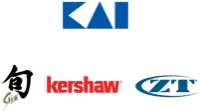
- 1800 SW Teton Avenue
- Tualatin, OR 97062
- Phone: 503-682-1966
- Toll Free: 800-325-2891
- Fax: 503-682-7168
- kaiusa.com
Knife Anatomy
What's the name of that part? The one between that piece and the other thing? Know the parts of a knife, from the tip to the butt with this quick guide.
Front view
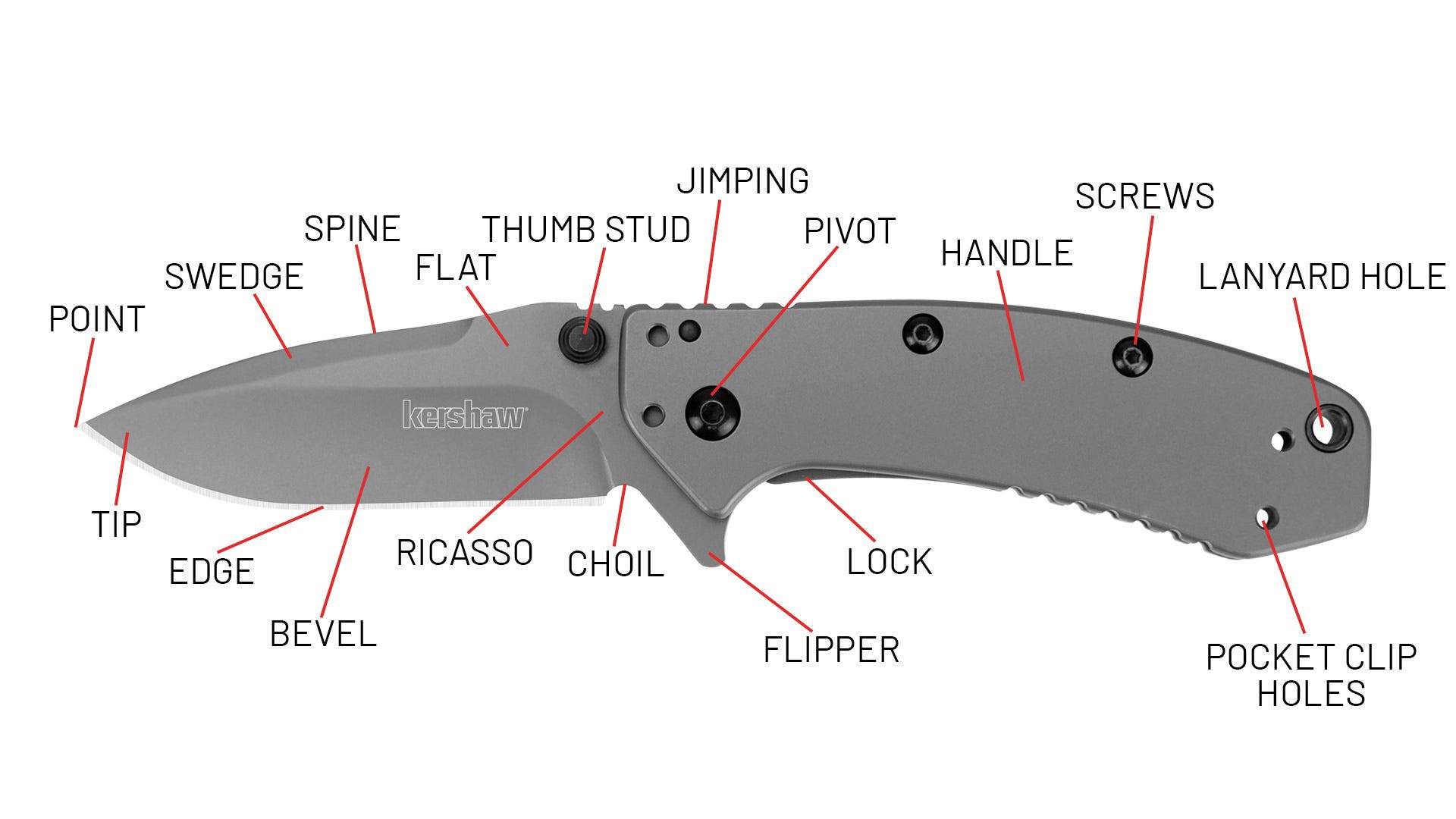
Front View Definitions
Point: The edge and the spine meet at the point of the knife, which is often used for piercing.
Tip: The front part of the blade that includes the tip. The tip is used for fine detail work.
Swedge: This is a tapered or beveled false edge near the spine of the blade. It reduces thickness to improve piercing.
Edge: The sharpened part of the blade that is used to slice and pierce through cutting tasks.
Bevel: A bevel is a blade grind that forms the blade edge.
Spine:This is the unsharpened top edge of the blade, opposite of the cutting edge.
Flat: The face of the knife without any grinds. It often includes the Kershaw logo and other lasered information about the knife.
Ricasso: The unsharpened portion of the blade between the grinds and handle. It thickens as it gets closer to the handle.
Thumb stud: A thumb stud is an opening mechanism. Users put pressure on the thumb stud with their thumb to push the blade into the open position.
Choil: An indented, curved notch behind the blade edge. It allows users to properly sharpen all the way to the end of the edge.
Jimping: A textured part of the handle that offers enhanced grip and ergonomics.
Flipper: A flipper is an opening mechanism. Users apply pressure to the flipper with their index finger to push the blade into the open position. .
Pivot: The part of a folding knife where the blade attaches to the handle.
Lock: Keeps the blade secure in the open position. Kershaw uses several kinds of locks in its folding knives, including the liner lock, frame lock, and crossbar DuraLock.
Handle: Users grip the handle to hold the knife and comfortably use the blade.
Screws: Secures the handle scales to the knife.
Pocket clip holes: Where the pocket clip is attached. Additional pocket clip holes allow users to swap the clip to alternative positions.
Lanyard hole: Allows users to attach a lanyard to the knife.
Back view
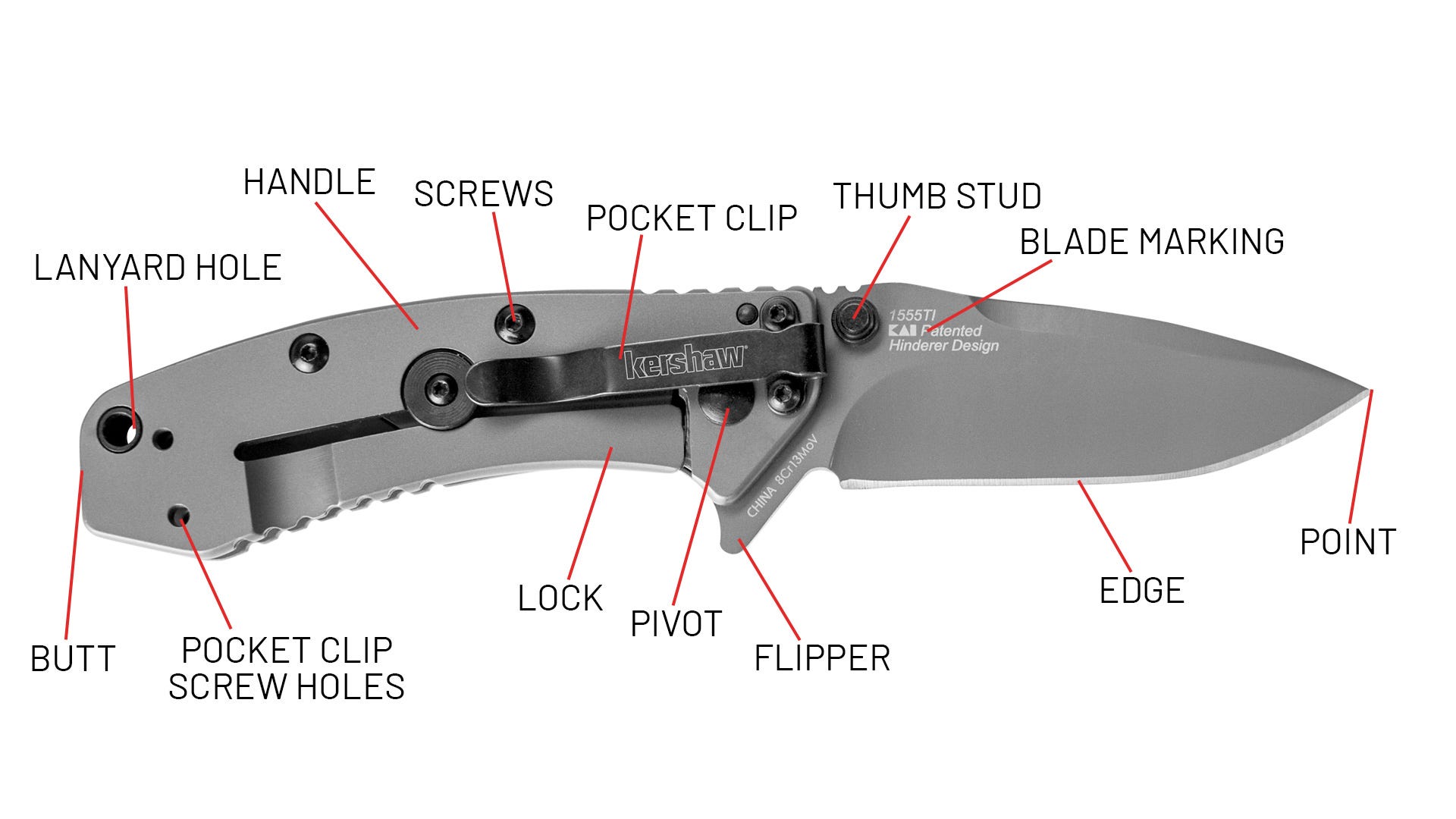
Back View Definitions
Butt: The back end of the handle that may contain a lanyard hole or pocket clip screws.
Lanyard hole: Allows users to attach a lanyard to the knife.
Pocket clip holes: Where the pocket clip is attached. Additional pocket clip holes allow users to swap the clip to alternative positions.
Handle: Users grip the handle to hold the knife and comfortably use the blade.
Screws: Secures the handle scales to the knife.
Lock: Keeps the blade secure in the open position. Kershaw uses several kinds of locks in its folding knives, including the liner lock, frame lock, and crossbar DuraLock.
Pocket clip: Allows users to attach the folded knife inside their pant pocket and carry it on-the-go.
Pivot: The part of a folding knife where the blade attaches to the handle.
Flipper: A flipper is an opening mechanism. Users apply pressure to the flipper with their index finger to push the blade into the open position. .
Thumb stud: A thumb stud is an opening mechanism. Users put pressure on the thumb stud with their thumb to push the blade into the open position.
Blade marking: Lasered etchings that provide information about the knife, including the model number.
Edge: The sharpened part of the blade that is used to slice and pierce through cutting tasks.
Point: The edge and the spine meet at the point of the knife, which is often used for piercing.
Bottom View
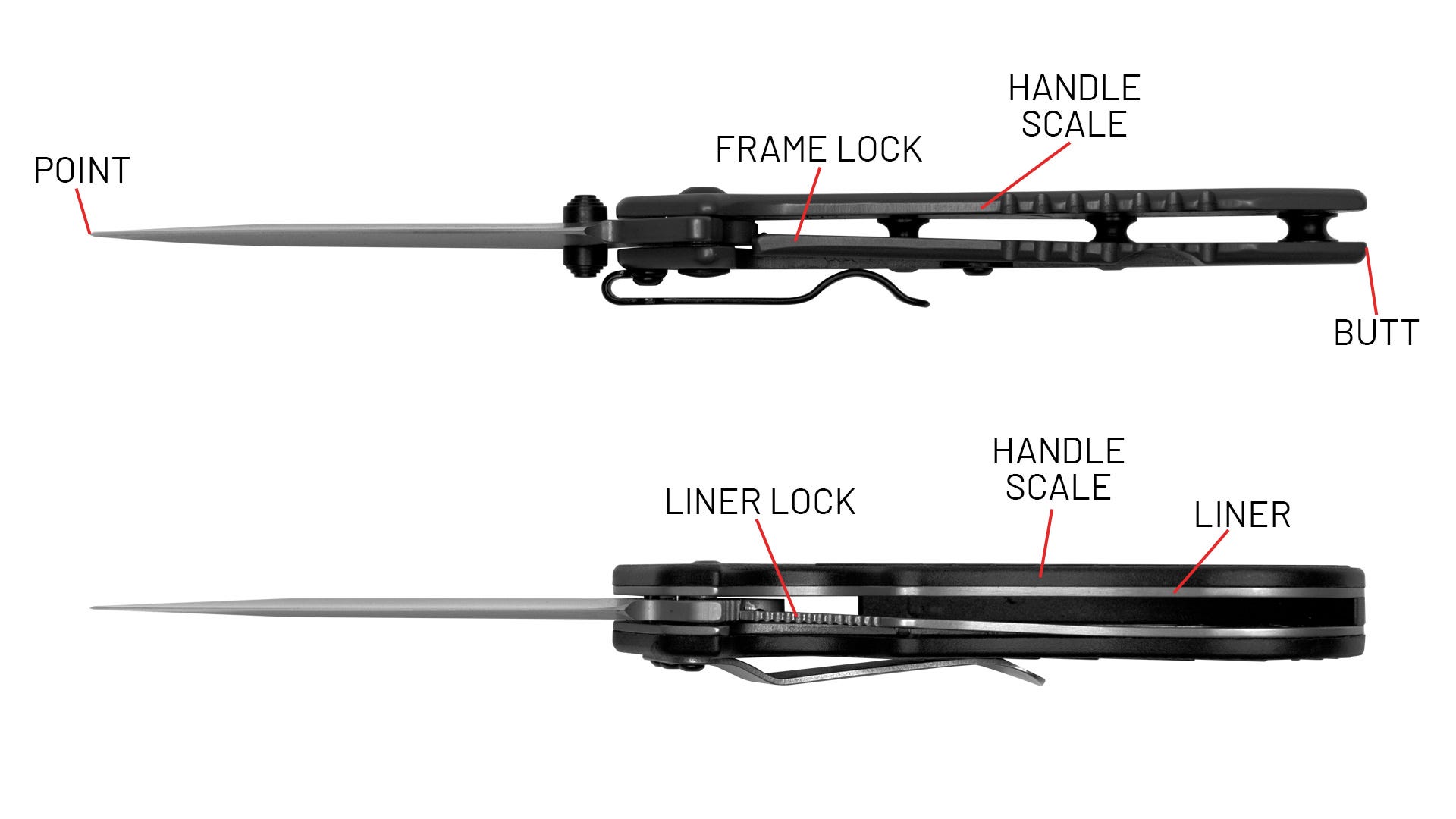
Bottom View Definitions
Point: The edge and the spine meet at the point of the knife, which is often used for piercing.
Frame lock: In a frame lock knife, the knife handle—its “frame”—consists of two plates of material on either side of the blade. When the knife is opened, the metal side of the frame, the lockbar, butts up against the backend of the blade (the tang) and prevents the blade from closing.
Handle scale: Covers the interior of the knife and creates a surface that users can grip.
Liner lock: In knives with locking liners, the handle consists of two metal plates (the “liner”) on either side of the blade. The locking liner secures the blade in the open position.
Liner: Flat pieces of metal inside the handle. Liners provide structure for the handle and pivot, and in liner lock knives, work as the blade lock.
Butt: The back end of the handle that may contain a lanyard hole or pocket clip screws.
Top View
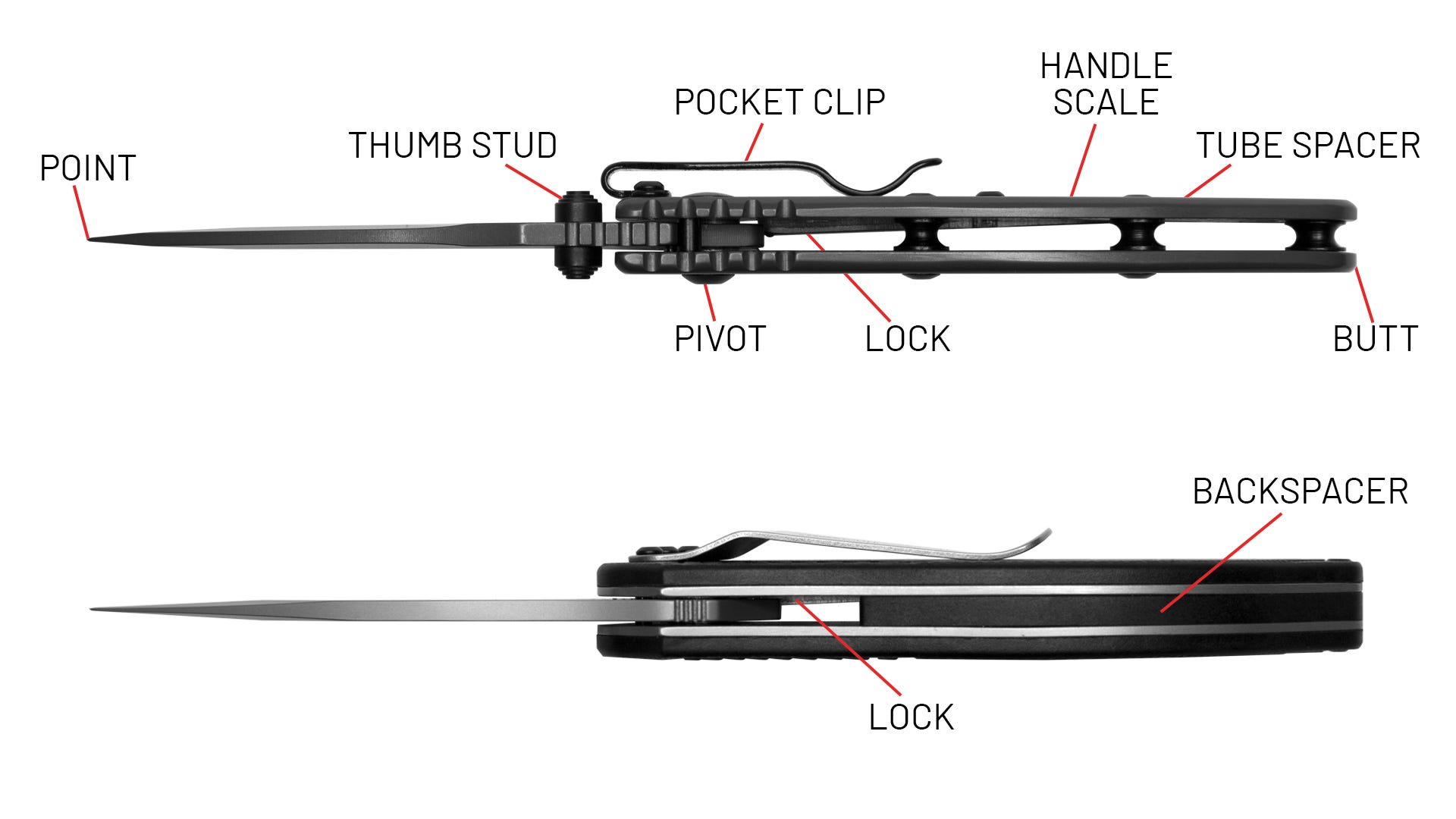
Top View Definitions
Point: The edge and the spine meet at the point of the knife, which is often used for piercing.
Thumb stud: A thumb stud is an opening mechanism. Users put pressure on the thumb stud with their thumb to push the blade into the open position.
Pivot: The part of a folding knife where the blade attaches to the handle.
Pocket clip: Allows users to attach the folded knife inside their pant pocket and carry it on-the-go.
Lock: Keeps the blade secure in the open position. Kershaw uses several kinds of locks in its folding knives, including the liner lock, frame lock, and crossbar DuraLock.
Handle scale: Covers the interior of the knife and creates a surface that users can grip.
Tube spacer: Often located within the spine of the knife. They secure the two handle scales together.
Handle: Users grip the handle to hold the knife and comfortably use the blade.
Butt: The back end of the handle that may contain a lanyard hole or pocket clip screws.
Backspacer: The enclosed area on the spine of the knife handle. It offers rigid construction and sometimes extra jimping.
